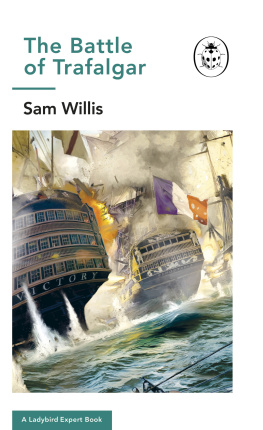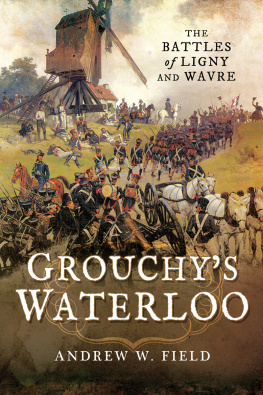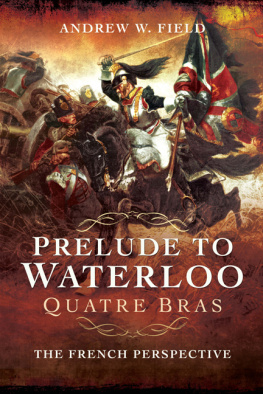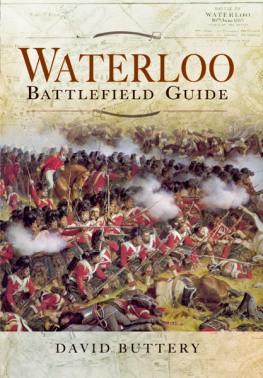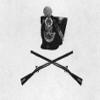Introduction
No battle or historic event has generated so many rumours, conflicting analyses, scholarly and anecdotal writings or legends as the battle of Waterloo.
Romantic writers have played their part. As soon as the site became accessible, Byron, Walter Scott, Robert Southey and others came and gave enduring life to all the statements, true or false, supplied by witnesses or pseudo-witnesses who they met. Chateaubriand managed the feat of telling the story of the conflict when he was fifty miles away and could only hear it. (Even that is doubtful!) Stendhal placed his character Fabrice del Dongo there without ever visiting himself. Dumas, when a refugee on the Boulevard de Waterloo in Brussels, took his friends there. Victor Hugo did the rest, making myths out of the tales of his predecessors, adding layers, and ensuring for Waterloo a real universal resonance.
The ravine formed by the sunken road, Cambronnes famous expletive, Grouchys strawberries, the three hundred corpses in the Hougoumont well, the excellent marriage made by a farmers wife at Plancenoit, the Prince of Oranges wound, the heroic deaths of Picton and of Marie Tte-de-bois originate from the imaginative genius of these great writers, whose writings have been so successful that they have been recopied, for a century, by pseudo-historians.
Other legends were born later concerning the forces present, the numbers of casualties, the construction of the Lion Mound, Wellingtons annuity, Napoleons absence during the fighting, the Duchess of Richmonds ball, Lord Uxbridges leg, the Rothschild fortune, the Emperors horses, the number of flags taken from the French, the fate of their guns, individual exploits, the toponymic origin of certain placenames, the mistakes made by some - or others, the choice of name for the battle, as well as the origin of all those Waterloos that are now to be found all around the world. Such legends have often gained currency due to the lack of contradictory evidence.
Even the cover of this book, representing the meeting of Wellington and Blcher, on the evening of the battle, at the Belle Alliance, whose original is exhibited in the Royal Gallery of the Palace of Westminster in London, is the result of a legend. As we will read later, Wellington himself denounced this fabrication.
This book has only one aim: to take stock of all these rumours, myths and legends and carefully try to separate the wheat from the chaff, to distinguish the true from the false, to clear away incongruities, and to recall some truths that some may find unpleasant to read, but which are needed to better understand certain events. With one risk: that of destroying some of the myths of this battlefield that is now celebrating the bicentennial of the most famous conflict that took place there.
But this book also seeks to be informative and to appeal to the general public. Purists and technical experts on the period, lovers of supplementary notes at the foot of every page, may remain unsatisfied. However, they will find at the end of the volume a bibliography that will allow them to extend their reading according to the topics they wish to pursue.
, to whom I dedicate this book, thanking them for all they have taught me and that I hope now to share with a greater number. As a simple passer-on of memory.
Yves Vander Cruysen
Waterloo, theatre of battles
Waterloo has often been the scene of conflicts. Simply because, over the centuries, armies defending or threatening Brussels had equal interest in securing the position of Waterloo, which guaranteed control of the Forest of Soignes which encircled the capital. Waterloo was also served by a paved road, much prized by armies. It thus became a real cornerstone for military strategists.
Since 1698, this small town, which was then only one of the villages which made up Braine lAlleud, has thus been occupied by various passing troops; with all that this may represent in the way of damage and sacrifices for local people.
On 17 August 1705, Waterloo was the scene of a first important conflict, opposing Marlboroughs troops against those of Jacques Pastur, known as Jaco, a popular figure in the region. This child of the country, worthy of the novels of Alexandre Dumas, was leader of a troop of toughs, ready for anything and devoted to their master, in the area around the hamlet of Roussart. Jaco put himself and his mercenaries, in turn, in the service of Spain and France. Between 1702 and 1705, he was thus charged by King Louis XIV to monitor the movements of Marlboroughs army, who had arrived on the old continent to reinforce the Austrian Habsburgs. It was in this context that, near his native village, he stoutly resisted the Anglo-Dutch troops when they tried to take possession of the strategic road connecting Charleroi with Brussels.
The fight lasted a good hour and a half. Seeing the enemy columns break through to his right, Pastur sounded a retreat, fearing encirclement. He withdrew his men, slowly and in good order, to Vivier dOie where they had erected a small fort, which became famous under the name of Fort Jaco. Marlboroughs troops did not dare venture into the forest. They contented themselves with plundering the village and settled down for the night. But they had not bargained for the pride of Jaco. Understanding the situation, he ordered his men to turn around. Half asleep, intoxicated by what they believed was their victory, the Anglo-Dutch could make no response to this surprise offensive. Pastur took hardly any time to clear the woods and to regain the village. Many Dutch and English soldiers fled into the forest, got lost and never returned. Many were killed.
The impact of this first battle of Waterloo has been treated quite unequally by historians. On the Allied side, memoirs have sought to minimise the real setback suffered by the troops of Marlborough. They treat the fight as a small skirmish of no importance. But even Winston Churchill, a direct descendant of the Duke of Marlborough, chose as title for the chapter on that period in the biography that he devoted to his illustrious ancestor The Unfought Waterloo. That is still doing considerable honour to a battle that, according to him, did not take place. In France, however, the celebration of the Waterloo affair was considerable and certainly out of proportion to the event. Thus, the little soldier of fortune, the guardian of the Forest of Soignes, who for so long had harassed the French, was presented to the Court of the Sun King. This happened on 17 or 18 March 1706, Louis XIV personally presenting him with a gold chain and a medal. The next day, Jaco, even though he had none of the four quarters of nobility required for this distinction, and despite the sovereigns usual avarice in these matters, received the Knights Cross of the Order of St. Lazarus and of Mount Carmel. Later, he was made a field marshal and ended his life, rich and famous, on a large estate he built in the heart of Waterloo. He dropped dead, unexpectedly, on 3 May 1723, while riding in a Brussels street where he also had property.
The people of Waterloo were left in peace for nearly a century. At most they saw rolling by, at the height of the Brabant revolution, the troops of General Friedrich Wilhelm von Schoenfeld, retreating before the Austrians. Or, on 20 November 1792, after the Battle of Jemappes, those of General Dumouriez which halted in the village before continuing their hunt for the Austrians.
On 6 and 7 July 1794, Waterloo bathed again in blood. This time it was the whole army of the Sambre and Meuse, of Generals Kleber and Lefebvre, which, just after the battle of Fleurus, arrived on the plain of Mont St Jean. It had before it the armies of the Prince of Orange, reinforced by the rearguard of the Austrian army commanded by the Prince of Cobourg. Cavalry charges and infantry fighting lasted several hours. And it was an intervention of General Lefebvres grenadiers, preceded by a new cavalry charge, that decided the fate of the first day. Interrupted by darkness, the battle started up again on 7 July, but more towards the village of Waterloo. Pushed back all along the line, the Prince of Orange had to withdraw to Mechelen. The exhausted victor, the husband of Madame Sans Gene, the most faithful among all Napoleons faithful, stopped in the village for the night, before making a triumphal entry, two days later, into Brussels.




